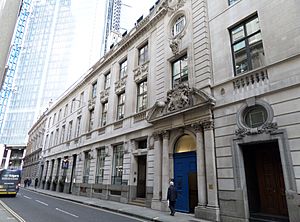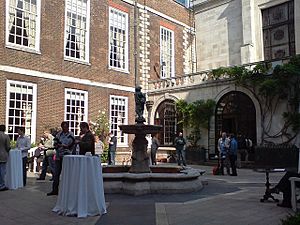Merchant Taylors' Hall, London facts for kids
The Merchant Taylors' Hall in London is a very old and important building. It's the home of the Worshipful Company of Merchant Taylors. This company is one of the "Twelve Great Livery Companies" of the City of London. These companies are like ancient clubs or guilds that have been around since the Middle Ages. They played a big role in London's history.
The Merchant Taylors' Company has been in this exact spot, between Threadneedle Street and Cornhill, since 1347. This makes it one of only about 40 old "livery halls" still standing in London today.
Contents
A Look Back: The Hall's History
The very first hall was built sometime between 1347 and 1392. Back then, it was simply called "Taillourshalle." For many years, until the terrible Great Fire of London in 1666, the building didn't change much. The only big repair was to the roof, which was rebuilt between 1586 and 1588.
Surviving the Great Fire
When the Great Fire of London happened in 1666, the Hall was badly damaged. The roof and everything inside burned away. Only the strong outer walls and foundations were left standing. But the Company didn't give up! They rebuilt the Hall, making it beautiful again with new tapestries, colourful stained glass windows, fancy chandeliers, and wooden panels.
Damage During World War II
Sadly, the Hall faced another big challenge during World War II. In September 1940, during the "London Blitz," German planes dropped incendiary bombs (fire bombs) on it. Many parts of the Hall were destroyed, including the main Hall itself, the galleries, the main entrance, the grand staircase, and several rooms.
However, some important parts of the building were lucky and survived the bombing. These included:
- The Library: This room held a special collection of old books, including first editions and other interesting volumes, mostly about London's history.
- The Court Room: The walls here are covered with portraits of past leaders of the Company. Above the fireplaces, you can see two carved Coats of Arms. These are like special badges that show the Company's history from 1480 and 1586.
- The Great Kitchen: Amazingly, this kitchen has been used continuously since 1425!
- Part of the Crypt: This is an underground area from a chapel built in the late 1300s.
Rebuilding and Modern Features
After World War II ended, it took several years to begin rebuilding the Hall. The main Hall finally reopened in March 1959. Even though the inside had been destroyed, the original walls and foundations were still strong. They were used in the new building. This means the restored Hall still has the same basic shape as the old one, even though the inside looks very different now.
Inside the Rebuilt Hall
Today, the Hall features beautiful mahogany wood panels and stunning stained glass windows. These windows show the special "arms" (symbols) of important people who were honorary members or who gave money to the Company. There's also a large Renatus Harris organ, which is a very impressive musical instrument.
The floor of the Hall today is almost at the same level as a wooden floor from 1793. You can even see parts of older floors through a special trapdoor! These include:
- A 14th-century floor made of beaten clay, which would have been covered with rushes.
- A red tile floor laid in 1646.
- A marble and stone floor from 1675.
Historic Treasures
Most of the Company's valuable silver and gold items (called "plate") are from the 1600s. This is because many older items were either sold to help the King during the English Civil War or were destroyed in the Great Fire of London. Only a few very old items survived from before these events:
- The Company's official seal, used for stamping important documents (from about 1502).
- A special measuring stick called a "Cloth-yard" (from before 1509).
- A 16th-century ceremonial mace, which is like a fancy staff carried in parades.
- Two beautiful "rosewater dishes" from 1590 and 1597, used for washing hands.
The Hall Today: Events and Visitors
Today, the Merchant Taylors' Hall is a busy place! It's often used for public events, managed by a special events company. It has hosted many different kinds of gatherings.
For example, in 2005, it was used for a photo shoot for the Harry Potter movie Harry Potter and the Goblet of Fire. The main actors, Daniel Radcliffe, Emma Watson, and Rupert Grint, were all there!
The Hall also hosts important government and administrative events. In 2008, for instance, the Mayor of London and the Greater London Authority held a program there about women in London's economy. Important politicians like Ken Livingstone, Harriet Harman MP, and Diane Abbott MP attended.



